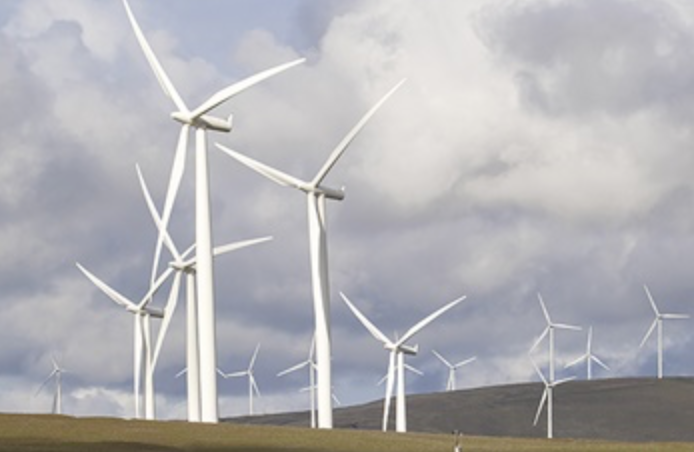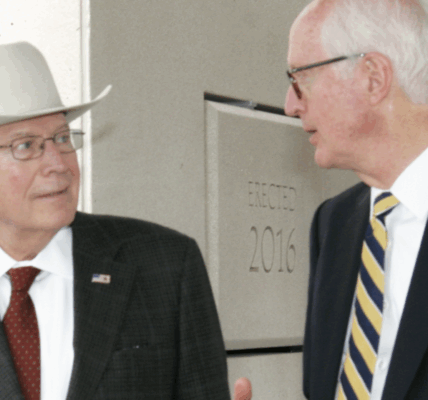
By Dustin Bleizeffer, WyoFile.com
Collisions with rotating wind turbine blades kill a variety of birds in Wyoming — from passerines to raptors. Exactly how many birds — and whether mortality rates might pose a threat to local and migrating bird populations — remains unknown, according to state and federal wildlife officials.
The overlap of strong, steady winds and prime wildlife habitat — such as for the greater sage grouse — also poses threats, unless wind energy facilities are located to avoid impacts to critical wintering, breeding and nesting areas. Designing wind facilities with these considerations requires the collection of wildlife and habitat data long before roads are carved, concrete pads are poured and wind turbines erected.
That’s the message of a former federal wildlife biologist who is sounding the alarm in an effort to encourage less harmful development as Wyoming’s wind energy is anticipated to boom.
Despite regulations and voluntary efforts to minimize wildlife impacts, Mike Lockhart and other biologists say wildlife officials must do better to collect more comprehensive data and apply more scrutiny to the industry.
“Most of the [Wyoming wind energy] development is just going off like a rocket right now, and we already have eagles that are getting killed by wind turbines — a hell of a lot more than people really understand,” Lockhart, a former U.S. Fish and Wildlife Service biologist, said.
Lockhart, who now works as a consultant for private companies, surveys eagle populations in Wyoming — mostly around Medicine Bow and in the Shirley Basin. The region is the “heart and soul” of golden eagle habitat in North America, he claims. Experimental wind turbines here date back to the 1980s, and it’s the epicenter of existing and prospective development ambitions.
Two key electrical transmission projects that will tie central Wyoming wind to several western states are expected to double the state’s wind energy capacity to 6,000 megawatts by 2030, according to those close to the industry.
While some wind energy representatives say tools exist to reap energy from the wind while conserving species, Lockhart contends that level of development will require much more planning to consider cumulative impacts to eagles, raptors, songbirds and all other wildlife. Additionally, the FWS should reconsider its “incidental take” allowance for individual wind energy facilities, he said.
“The Fish and Wildlife Service has provided an allowable take for those [individual] projects of 10 to 14 eagles per year,” Lockhart said. “You multiply that out by the 30-year project life — that’s a hell of a lot of eagles, and they can’t sustain that kind of impact.”
In a landmark case, Duke Energy Corp. was fined $1 million for killing 14 eagles and 149 other birds at four wind farms in Wyoming from 2009 to 2013. The company “failed to make all reasonable efforts to build the projects in a way that would avoid the risk of avian deaths by collision with turbine blades, despite prior warnings about this issue from the U.S. Fish and Wildlife Service,” according to the U.S. Department of Justice.
ESI Energy Inc., and its affiliate NextEra Energy, were fined $8 million in April for killing more than 150 eagles in several states over a 10-year period, including at wind facilities in Carbon and Laramie counties.
In both cases, the companies failed to acquire federal “incidental take” permits, which can protect operators from running afoul of the Migratory Bird Treaty Act. But Lockhart questions the justification of allowable incidental take numbers, as well as the FWS’s current level of accounting and analysis for the potential cumulative impact to bird populations from multiple, individually permitted wind farms within a region.
“All of them [wind facilities] are impacting eagles, without a doubt,” Lockhart said. “But the extent of those impacts probably varies wildly, and I just don’t know what it is. And I’m not sure anybody does.”
An estimated 538,000 birds are killed by land-based wind turbines each year in the U.S., according to an article by the American Bird Conservancy analyzing data from the U.S. Wind Turbine Database. A FWS estimate suggests an average 234,012 bird kills annually, as of 2017. The FWS was unable to respond to WyoFile’s inquiries in time for this story.
There’s no research that indicates wind turbine blade strikes threaten any bird species at a population level, according to Wyoming Game and Fish Department Deputy Director Angi Bruce. However, the agency, which analyzes potential avian impacts, is concerned that might already be the case, “especially when you look at locations that have multiple wind farms,” she said. “Understanding the cumulative effects is still ongoing and not conclusive at this time.”
For all of the advantages of wind energy — a free fuel supply, low carbon footprint and freedom from volatile international commodity markets — wind energy does come with inherent downsides such as spoiled viewsheds. Devastating avian mortality, and other wildlife impacts, don’t have to be part of the equation, Power Company of Wyoming Communications Director Kara Choquette said.
“The tools are there and available, and partnerships are possible with the Fish and Wildlife Service to achieve conservation goals — and that’s something we chose to do,” Choquette said.
Power Company of Wyoming’s Sierra Madre and Chokecherry Wind Energy Project in Carbon County has been completely reconfigured since its inception more than a decade ago, based on continuous wildlife surveys as well as advancing technology. Rather than 1,000 wind turbines, the project will include 600 turbines, thanks to larger and more efficient wind turbine designs, for example. Turbines will be placed away from ridgelines based on continuous bird flight surveys, Choquette said, and ongoing observations via towers and cameras will help inform adaptive management practices, such as shutting down wind turbines when birds are active in the area.
“It’s literally going through and screening all of the datasets and really trying to find the best place and working to avoid and minimize potential impacts on avian species,” Choquette said. “It’s a big part of our job.”
PacifiCorp owns and operates the largest number of wind facilities in the state, and it plans to continue expanding its wind energy capacity here. The utility collects “several years” of wildlife data to inform where it locates wind turbines and how to mitigate impacts during operations.
“These surveys typically include habitat and usage surveys for avian, bat, and various wildlife species, including elk/ antelope (crucial winter range), prairie dogs, swift fox, greater sage grouse, and other protected species,” PacifiCorp states in a fact sheet.
Efforts include “buffer zones” to distance facilities from nests and holding off on construction activities during certain times of the year. Both PacifiCorp and Power Company of Wyoming are retrofitting power poles to discourage nesting and perching.
“Our objective is no [wildlife] mortalities,” PacifiCorp spokesperson David Eskelsen said. “If any do occur for protected species, they are reported to [the FWS] within 24 hours.”
For all the federal and state regulations and oversight, local officials still don’t have a full understanding of the industry’s impact on raptors and other wildlife, according to Carbon County Commissioner Sue Jones.
“To be quite honest, we don’t hear a lot and there’s no way to tell, as far as I know,” Jones said. Many areas of Carbon County, particularly around Medicine Bow, have become “industrialized” with wind energy, she said. As with any energy development, planning and proper siting is vital to balance natural resources. “There’s a tipping point, and we have lost things that are not replaceable, like viewsheds, literally.”




